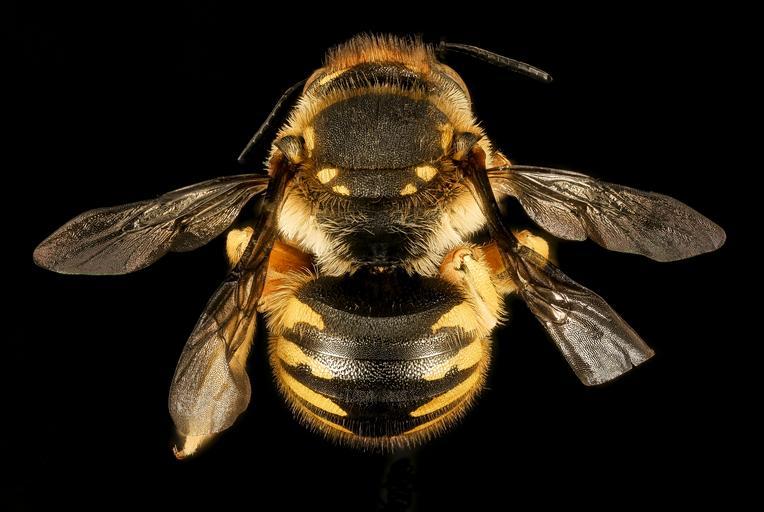MAKE A MEME
View Large Image

| View Original: | Anthidium_manicatum,_F,_back,_MA,_Middlesex_Co_2015-11-03-16.12.12_ZS_PMax_UDR.jpg (5002x3350) | |||
| Download: | Original | Medium | Small | Thumb |
| Courtesy of: | www.flickr.com | More Like This | ||
| Keywords: bee bees bug anthidium anthidium manicatum anthidiummanicatum massachusetts middlesex taxonomy: binomial = anthidium manicatum taxonomybinomialanthidiummanicatum us geological survey usgeologicalsurvey yellow patuxent wildlife research center patuxentwildliferesearchcenter droege dejen mengis dejenmengis dofstacking stacking stackshot zerene stacker zerenestacker focus stacking focusstacking line very megachilidae hymenoptera black background blackbackground yellow leg yellowleg animal moth insect What a lovely female Anthidium manicatum from Massachusetts. This species is a non-native species that has successfully invaded much of the Eastern parts of North America, in particular it is fond of ornamental gardens containing furry leaved plants which it uses to line its nest. Note the ripples along the edge of the clypeus or the regulations… Distinctive and the species. Photography by Dejen Mengis. ~~~~~~~~~~{{{{{{0}}}}}}~~~~~~~~~~ All photographs are public domain, feel free to download and use as you wish. Photography Information: Canon Mark II 5D, Zerene Stacker, Stackshot Sled, 200mm Pentax-m with Nikon 10X infinity microscope objective lens mounted on front , Twin Macro Flash in Styrofoam Cooler, F5.6, ISO 100, Shutter Speed 200 Love for Other Things It’s easy to love a deer But try to care about bugs and scrawny trees Love the puddle of lukewarm water From last week’s rain. Leave the mountains alone for now. Also the clear lakes surrounded by pines. People are lined up to admire them. Get close to the things that slide away in the dark. Be grateful even for the boredom That sometimes seems to involve the whole world. Think of the frost That will crack our bones eventually. - Tom Hennen You can also follow us on Instagram account USGSBIML Want some Useful Links to the Techniques We Use? Well now here you go Citizen: Basic USGSBIML set up: www.youtube.com/watch?v=S-_yvIsucOY USGSBIML Photoshopping Technique: Note that we now have added using the burn tool at 50% opacity set to shadows to clean up the halos that bleed into the black background from "hot" color sections of the picture. www.youtube.com/watch?v=Bdmx_8zqvN4 PDF of Basic USGSBIML Photography Set Up: ftp://ftpext.usgs.gov/pub/er/md/laurel/Droege/How%20to%20Take%20MacroPhotographs%20of%20Insects%20BIML%20Lab2.pdf Google Hangout Demonstration of Techniques: plus.google.com/events/c5569losvskrv2nu606ltof8odo or www.youtube.com/watch?v=4c15neFttoU Excellent Technical Form on Stacking: www.photomacrography.net/ Contact information: Sam Droege sdroege@usgs.gov 301 497 5840 What a lovely female Anthidium manicatum from Massachusetts. This species is a non-native species that has successfully invaded much of the Eastern parts of North America, in particular it is fond of ornamental gardens containing furry leaved plants which it uses to line its nest. Note the ripples along the edge of the clypeus or the regulations… Distinctive and the species. Photography by Dejen Mengis. ~~~~~~~~~~{{{{{{0}}}}}}~~~~~~~~~~ All photographs are public domain, feel free to download and use as you wish. Photography Information: Canon Mark II 5D, Zerene Stacker, Stackshot Sled, 200mm Pentax-m with Nikon 10X infinity microscope objective lens mounted on front , Twin Macro Flash in Styrofoam Cooler, F5.6, ISO 100, Shutter Speed 200 Love for Other Things It’s easy to love a deer But try to care about bugs and scrawny trees Love the puddle of lukewarm water From last week’s rain. Leave the mountains alone for now. Also the clear lakes surrounded by pines. People are lined up to admire them. Get close to the things that slide away in the dark. Be grateful even for the boredom That sometimes seems to involve the whole world. Think of the frost That will crack our bones eventually. - Tom Hennen You can also follow us on Instagram account USGSBIML Want some Useful Links to the Techniques We Use? Well now here you go Citizen: Basic USGSBIML set up: www.youtube.com/watch?v=S-_yvIsucOY USGSBIML Photoshopping Technique: Note that we now have added using the burn tool at 50% opacity set to shadows to clean up the halos that bleed into the black background from "hot" color sections of the picture. www.youtube.com/watch?v=Bdmx_8zqvN4 PDF of Basic USGSBIML Photography Set Up: ftp://ftpext.usgs.gov/pub/er/md/laurel/Droege/How%20to%20Take%20MacroPhotographs%20of%20Insects%20BIML%20Lab2.pdf Google Hangout Demonstration of Techniques: plus.google.com/events/c5569losvskrv2nu606ltof8odo or www.youtube.com/watch?v=4c15neFttoU Excellent Technical Form on Stacking: www.photomacrography.net/ Contact information: Sam Droege sdroege@usgs.gov 301 497 5840 | ||||